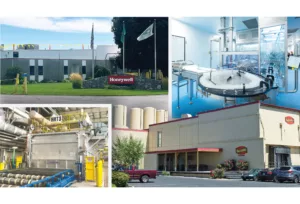
Construction activity to stabilize at slower rate in 2025
North Spokane Corridor is under bidding pause
_web.webp?t=1734050391&width=790)
Permitted multifamily units—such as the 36-unit Falls Tower luxury condominium building under development on Spokane's North Bank neighborhood—are up over 12% in Spokane County, but the market is showing signs of stabilization after significant growth in the last two years.
| Karina EliasA burst of construction permitting activity in the beginning of the year has given way to a development slowdown that's projected to stabilize at a slower rate in 2025--and feature a mix of resilience in the private sector and uncertainty for state transportation projects.
A bidding freeze on new transportation projects, called for by the Washington state Department of Transportation, likely will hamper infrastructure construction activity in the new year, says Cheryl Stewart, executive director at Associated General Contractors Inland Northwest.
Notably, the next two phases of work on the North Spokane Corridor are being impacted by the bidding pause.
"That's a huge impact on our industry right now that they're not bidding anything," says Stewart, adding that the duration of the freeze is unknown and has affected about $250 million in halted projects.
Despite the bidding freeze, some funding already has been secured for other road maintenance and preservation work, Stewart says.
Private commercial construction activity in Eastern Washington next year will be more resilient than state transportation projects. Private sector developments will include more multifamily, manufacturing, data center, and warehouse facilities in the region, she adds.
The new year also will bring continued wage growth, rising material prices and land prices, and higher financing costs, which all are contributing to rising construction costs, says Stewart.
A lack of skilled labor also will impact commercial project costs and timelines in 2025. Some workforce relief is expected through AGC's apprenticeship programs and youth outreach efforts, which Stewart says are making an impact on the school-to-workforce pipeline.
A projected revenue shortfall in Washington state and the potential for federal policy changes focused on immigration and tariffs likely will contribute to a slowdown in construction activity in the Spokane area in 2025, compared to activity over the last two years.
Overall, Stewart says that the economic optimism for the new year is expected to overlay into the construction market.
"In the construction industry, everyone thinks the economy is going to improve, which means construction is going to improve. There's a lot of fear mongering out there as far as tariffs and immigration policy ... but we just don't know what's going to happen yet."
The residential construction sector has grown year-over-year with 11% more residential units permitted in Spokane County through the first three quarters of 2024 compared to the year-earlier period.
Joel White, executive officer of the Spokane Home Builders Association, says multifamily permits issued from Jan. 1 to Oct. 31 are up over 12%, compared to the year-earlier period, and are showing signs of stabilization after significant growth in 2022 and 2023, according to data provided to White by the Construction Monitor.
Permits for duplexes and the number of duplex units both declined about 28% in Spokane County from Jan. 1 to Oct. 31, compared to the year-earlier period. While the number of permits for multifamily structures declined over 3%, the number of total units increased about 16%.
Single-family permits also increased 9% in the first three quarters of 2024, compared with the year-earlier period.
Although residential construction activity in Spokane County has increased overall, it has started cooling down after an uptick in permit activity in the beginning of the year, says White.
"We're in a slowdown right now," he says.
Slight gains in early 2024 were fueled by preemptive permit filings by builders who submitted permit applications early to get ahead of new building code changes that went into effect in February.
Residential construction activity in the new year will be impacted by housing affordability challenges, says White, adding that a shift away from the development of owner-occupied units has emerged this year.
"We're seeing a lot more of the housing stock is going to be ... renter occupied," says White.
The shift away from the development of owner-occupied units is being driven by a combination of investor preference, affordability, and changing demographics, explains White.
"Right now, a lot of land is locked up," White says. "Certain large builders and investors have secured large parcels of land that they're choosing not to build on right now and are waiting to see when the market will change."
Going forward, White says he expects to see residential construction involve more duplexes and accessory dwelling units being developed on single-family lots and the repurposing of some vacant office space into residential use in the Spokane market.
In the city of Spokane, nearly 30 new and ongoing projects worth about $61.5 million are on the books in 2025, with the city planning to prioritize pedestrian and bicycle safety, road resurfacing, and utility infrastructure improvements next year, says Marlene Feist, public works director for the city of Spokane.
The city's public works spending is down from about $110 million in new and ongoing public works projects that were scheduled in 2024.
While not as robust as spending in previous years, Feist says the city has a strong pipeline of public works projects along with funding opportunities in 2025, which are reasons for optimism in the new year.
The reduced value of public works projects in 2025 reflects the completion of several key projects this year, including the reopening of the $30 million Post Street Bridge, concrete work at the Thor-Freya intersection, deck work on the Washington-Stevens corridor, and new water and sewer infrastructure projects throughout the city, she says.
Public works projects in the new year will address community concerns in the Latah Valley neighborhood, where a $2 million J-turn will be installed at Meadowlane Road and U.S. 195, says Feist.
Additionally, work valued at about $8 million is planed to relocate water and sewer lines to accommodate the construction of the North Spokane Corridor; a $4.5 million water booster station will help support growth on the West Plains; and a $3.5 million streetscape project will improve sidewalks, lighting, and trees on Lincoln Street to create a pedestrian-friendly connection between the Post Street Bridge and entertainment venues on the North Bank.
The public works department also will seek grant funding in the new year for the upcoming $65 million Latah Bridge replacement project, says Feist.
"We're excited about what we accomplished this year and what's coming ahead for the community in terms of infrastructure," Feist says.



_web.webp?t=1764835652)
